BUICK REGAL 1998 Manual PDF
Manufacturer: BUICK, Model Year: 1998, Model line: REGAL, Model: BUICK REGAL 1998Pages: 388, PDF Size: 20.19 MB
Page 71 of 388
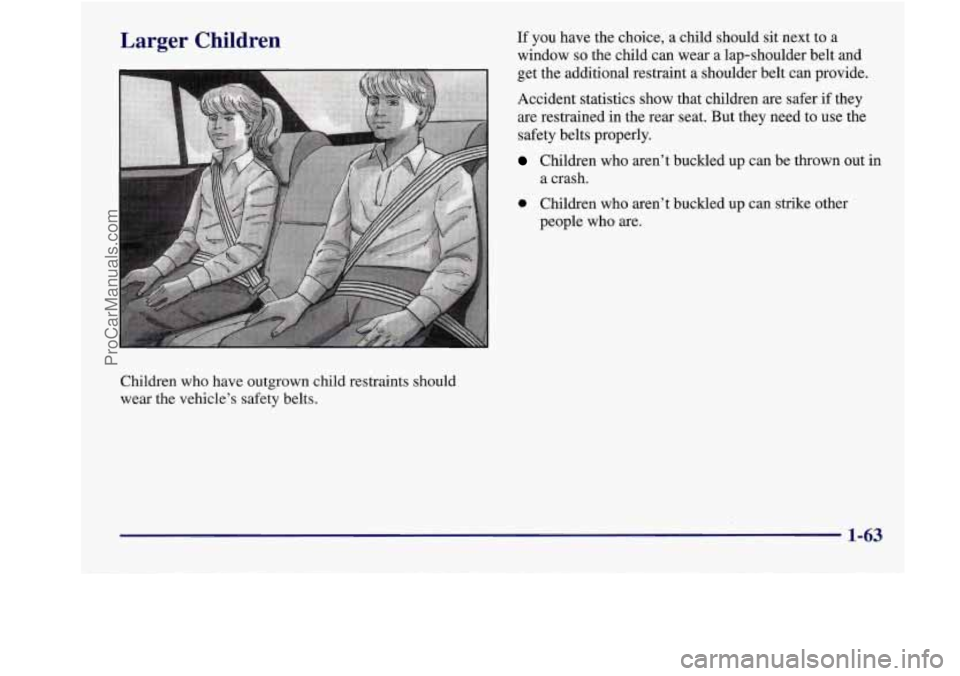
Larger Children
Children who have outgrown child restraints should
wear the vehicle’s safety belts.
If you have the choice, a child should sit next to a
window
so the child can wear a lap-shoulder belt and
get the additional restraint a shoulder belt can provide.
Accident statistics show that children are safer
if they
are restrained in the rear seat. But they need to use the
safety belts properly.
Children who aren’t buckled up can be thrown out in
a crash.
0 Children who aren’t buckled up can strike other
people who are.
1-63
ProCarManuals.com
Page 72 of 388
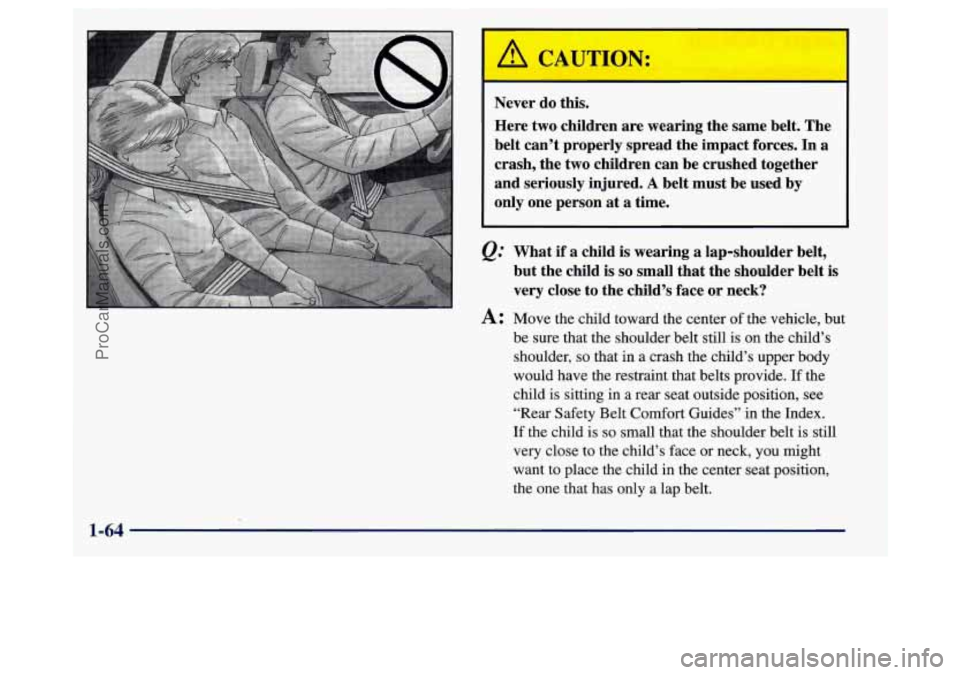
Never do this.
Here two children are weanng me same belt. The
belt can't properly spread the impact forces. In
a
crash, the two children can be crushed together
and seriously injured.
A belt must be used by
only one person at a time.
Q: What if a child is wearing a lap-shoulder belt,
but the child is
so small that the shoulder belt is
very close to the child's face or neck?
A: Move the child toward the center of the vehicle, but
be sure that the shoulder belt still is on the child's
shoulder,
so that in a crash the child's upper body
would have the restraint that belts provide. If the
child is sitting in a rear seat outside position, see
"Rear Safety Belt
Comfort Guides" in the Index.
If the child is
so small that the shoulder belt is still
very close to the child's face or neck, you might
want to place the child in
the center seat position,
the one that
has only a lap belt.
1-64
ProCarManuals.com
Page 73 of 388
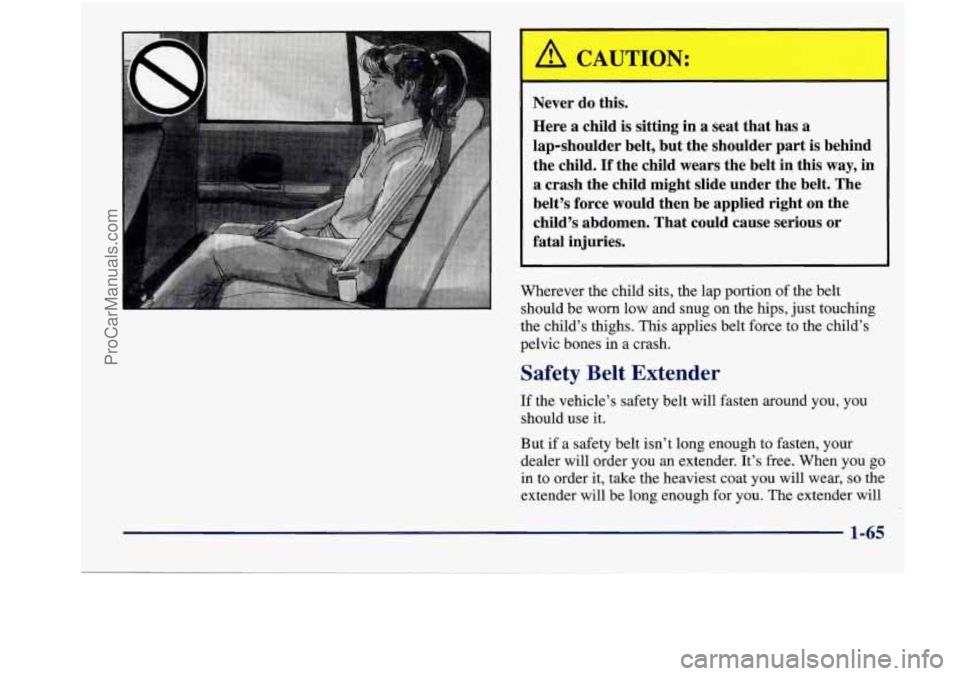
Never do this.
Here a child is sitting in
a seat that has a
lap-shoulder belt, but the shoulder part is behind
the child.
If the child wears the belt in this way, in
a crash the child might slide under the belt. The
belt’s force would then be applied right on the
child’s abdomen. That could cause serious or
fatal injuries.
Wherever the child sits, the lap portion of the belt
should be worn low and snug on the hips, just touching
the child’s thighs.
This applies belt force to the child’s
pelvic bones in a crash.
Safety Belt Extender
If the vehicle’s safety belt will fasten around you, you
should use it.
But if a safety belt isn’t long enough to fasten, your
dealer will order you an extender. It’s free. When you
go
in to order it, take the heaviest coat you will wear, so the
extender will be long enough for you. The extender will
1-65
ProCarManuals.com
Page 74 of 388
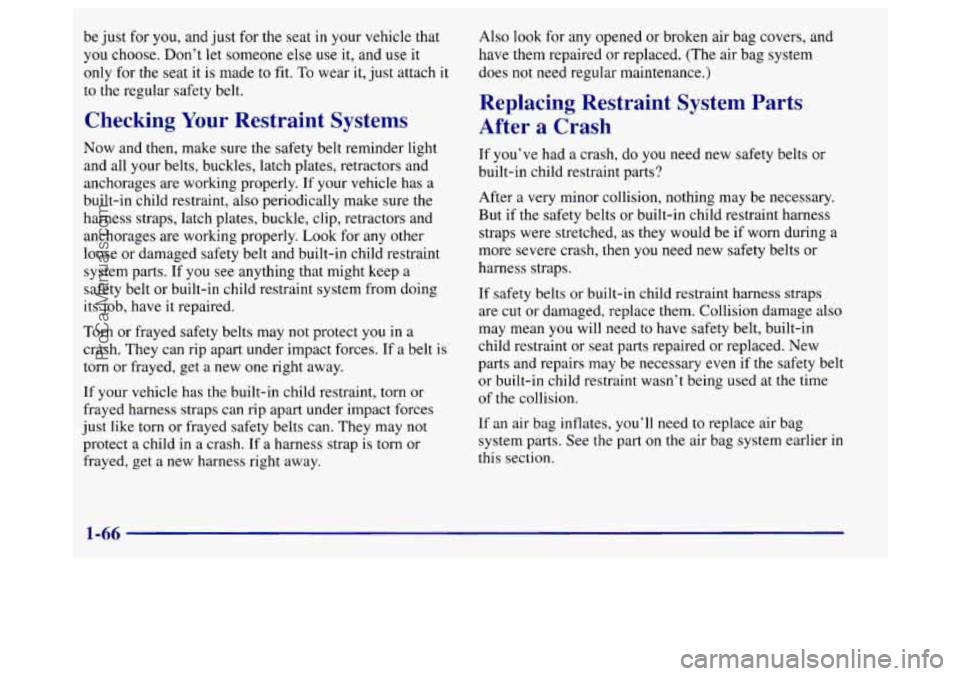
be just for you, and just for the seat in your vehicle that
you choose. Don’t let someone else
use it, and use it
only for the seat
it is made to fit. To wear it, just attach it
to the regular safety belt.
Checking Your Restraint Systems
Now and then, make sure the safety belt reminder light
and all your belts, buckles, latch plates, retractors and
anchorages are working properly.
If your vehicle has a
built-in child restraint, also periodically make sure the
harness straps, latch plates, buckle, clip, retractors and
anchorages are working properly. Look for any other
loose or damaged safety belt and built-in child restraint
system parts. If you see anything that might keep a
safety belt or built-in child restraint system from doing
its job, have it repaired.
Torn or frayed safety belts may not protect you
in a
crash. They can rip apart under impact forces. If a belt is
torn or frayed, get a new one right away.
If
your vehicle has the built-in child restraint, torn or
frayed harness straps can rip apart under impact forces
just like torn or frayed safety belts can.
They may not
protect a child
in a crash. If a harness strap is torn or
frayed, get a new harness right away. Also look
for any opened or broken air bag covers, and
have them repaired or replaced. (The air bag system
does not need regular maintenance.)
Replacing Restraint System Parts
After
a Crash
If you’ve had a crash, do you need new safety belts or
built-in child restraint parts?
After a very minor collision, nothing may be necessary.
But if the safety belts
or built-in child restraint harness
straps were stretched, as
they would be if worn during a
more severe crash, then you need new safety belts or
harness straps.
If safety belts or built-in child restraint harness straps
are cut or damaged, replace them. Collision damage also
may mean you will need to have safety belt, built-in
child restraint or seat parts repaired or replaced. New
parts and repairs may be necessary even if the safety belt
or built-in child restraint wasn’t being used at
the time
of the collision.
If an air bag inflates, you’ll need to replace air bag
system parts. See the part
on the air bag system earlier in
this section.
1-66
ProCarManuals.com
Page 75 of 388
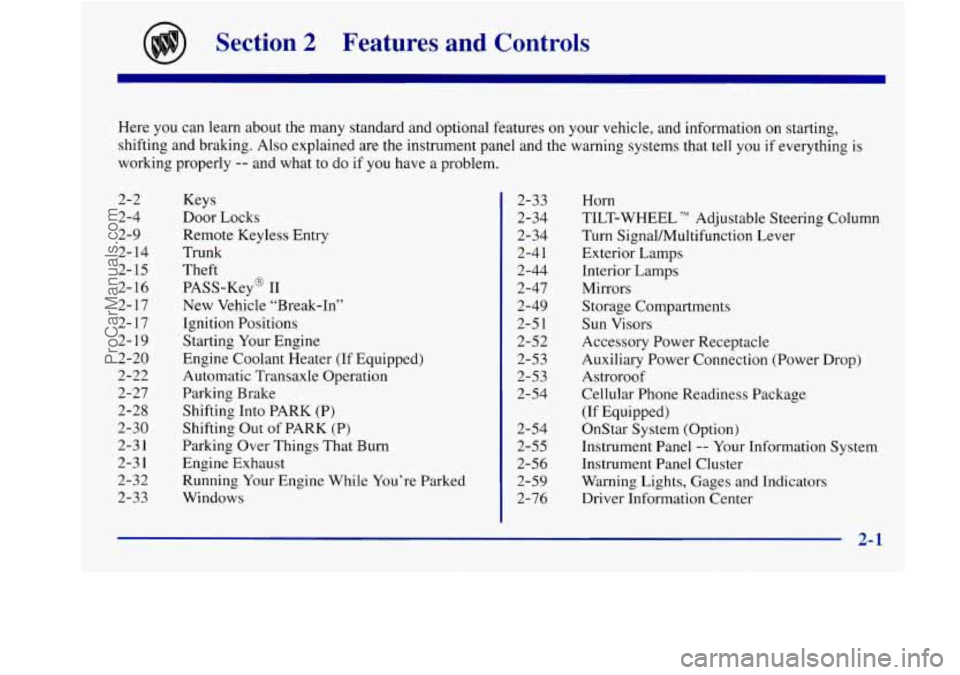
Section 2 Features and Controls
Here you can learn about the many standard and optional features on your vehicle, and information on starting,
shifting and bralung. Also explained are the instrument panel and the warning systems that tell you
if everything is
working properly
-- and what to do if you have a problem.
2-2
2-4
2-9
2- 14
2- 15
2- 16
2- 17
2-1 7
2- 19
2-20
2-22
2-27
2-28
2-30
2-3 1
2-3 1
2-32
2-33 Keys
Door Locks
Remote Keyless Entry
Trunk
Theft
PASS-Key@ I1
New Vehicle “Break-In”
Ignition Positions Starting Your Engine
Engine Coolant Heater (If Equipped)
Automatic Transaxle Operation
Parking Brake
Shifting Into PARK (P)
Shifting
Out of PARK (P)
Parking Over Things That Burn
Engine Exhaust Running Your Engine While You’re Parked
Windows 2-33
2-34
2-34
2-4 1
2-44
2-47
2-49
2-5 1
2-52
2-53
2-53
2-54
2-54
2-55
2-56
2-59
2-76 Horn
TILT-WHEEL
TM Adjustable Steering Column
Turn Signal/Multifunction Lever
Exterior Lamps
Interior Lamps
Mirrors
Storage Compartments
Sun Visors
Accessory Power Receptacle
Auxiliary Power Connection (Power Drop)
Astroroof
Cellular Phone Readiness Package
(If Equipped)
OnStar System (Option)
Instrument Panel
-- Your Information System
Instrument Panel Cluster
Warning Lights, Gages and Indicators
Driver Information Center
2-1
ProCarManuals.com
Page 76 of 388
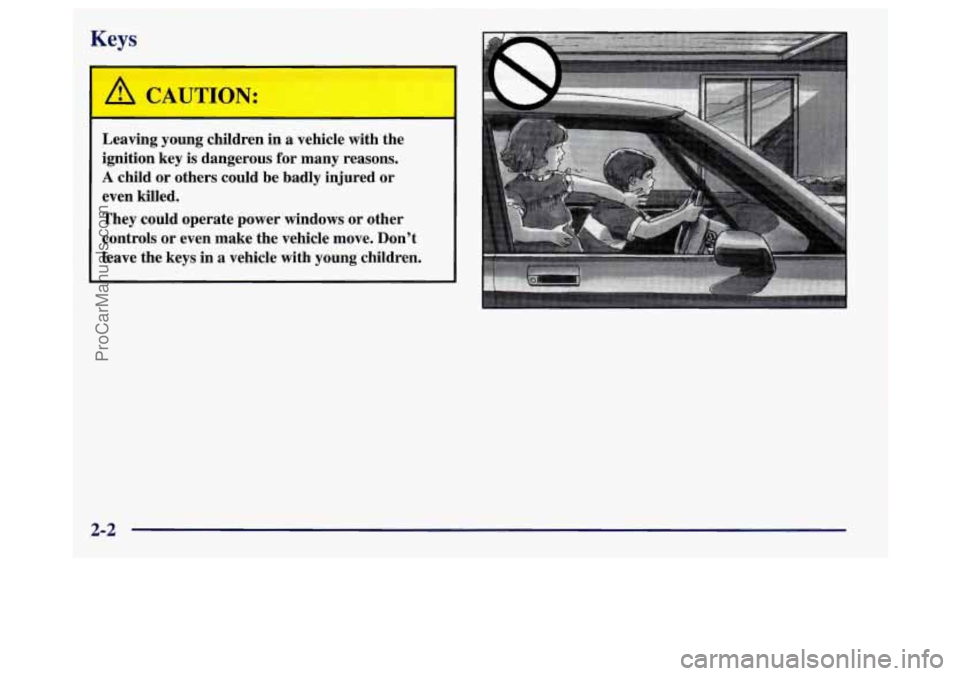
Keys
fi CAUTION:
Leaving young children in a vehicle with the
ignition key is dangerous for many reasons.
A child or others could be badly injured or
even killed.
They could operate power windows or other
controls or even make the vehicle move. Don't
leave the keys in
a vehicle with young children.
2-2
ProCarManuals.com
Page 77 of 388
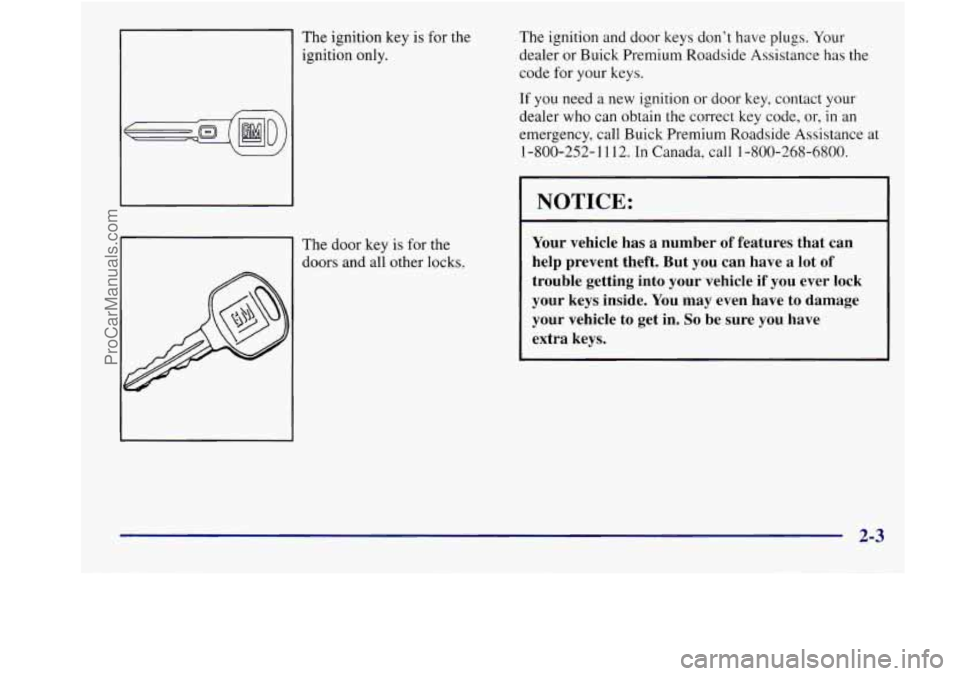
The ignition key is for the
The door key
is for the
doors and all other locks. The
ignition and door keys don’t have plugs.
Your
dealer or Buick Premium Roadside Assistance has the
code for your keys.
If you need a new ignition or door key, contact your
dealer who can obtain the correct key code,
or, in an
emergency, call Buick Premium Roadside Assistance
at
1-800-252- 1 1 12. In Canada, call 1-800-268-6800.
NOTICE:
Your vehicle has a number of features that can
help prevent theft. But you can have a lot
of
trouble getting into your vehicle if you ever lock
your keys inside. You may even have to damage
your vehicle
to get in. So be sure you have
extra keys.
2-3
ProCarManuals.com
Page 78 of 388
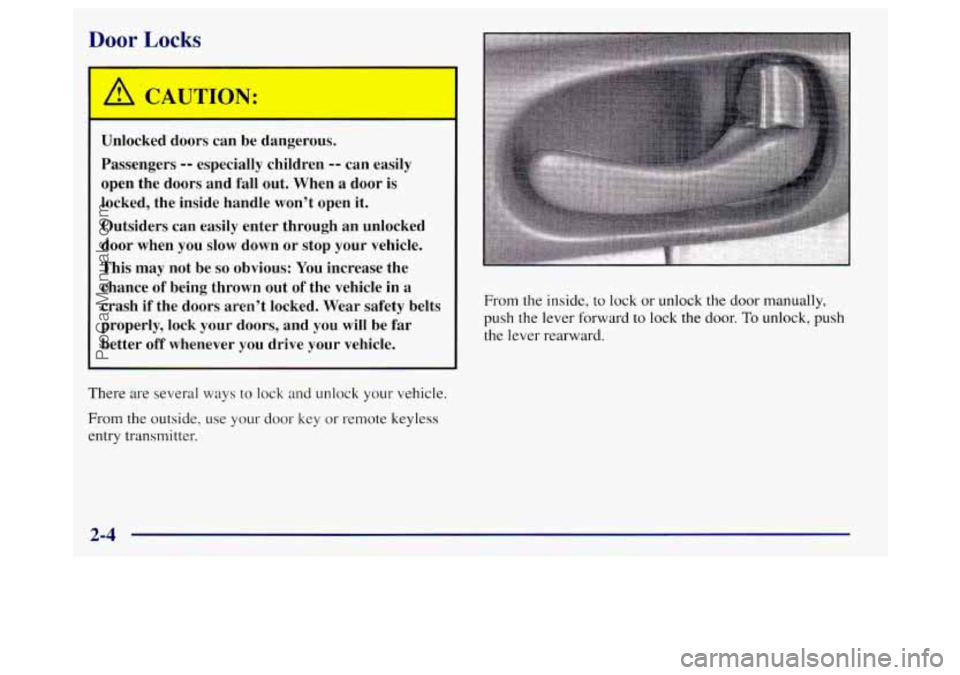
Door Locks
Unlocked doors can be dangerous.
Passengers
-- especially children -- can easily
open the doors and fall out. When
a door is
locked, the inside handle won’t open it.
Outsiders can easily enter through an unlocked
door when you slow down
or stop your vehicle.
This may not be
so obvious: You increase the
chance of being thrown out of the vehicle in a
crash if the doors aren’t locked. Wear safety belts
properly, lock your doors, and you will be
far
better off whenever you drive your vehicle.
There are several ways to lock and
unlock your vehicle.
From the outside,
use your door key or remote keyless
entry transmitter. From
the inside,
to lock or unlock the door manually,
push the lever forward
to lock the door. To unlock, push
the lever rearward.
2-4
ProCarManuals.com
Page 79 of 388
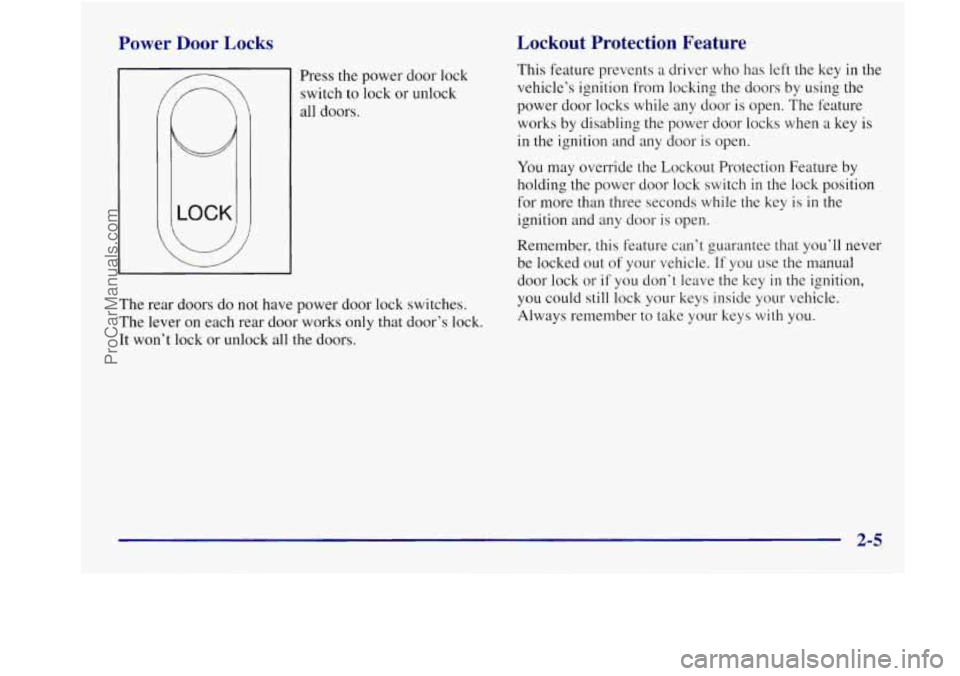
Power Door Locks
/-
E
Press the power door lock
switch to lock or unlock
all doors.
The rear doors do not have power door lock switches.
The lever on each rear door works only that door’s lock.
It won’t lock or unlock all the doors.
Lockout Protection Feature
This feature prevents a driver who has left the key in the
vehicle’s ignition from locking the doors by using the
power door locks while any
door is open. The feature
works by disabling the power
door locks when a key is
in the ignition and any door is open.
You may override the Lockout Protection Feature by
holding the power door lock switch
in the lock position
for more than three seconds while the key is
in the
ignition and any door
is open.
Remember, this feature can’t guarantee that you’ll never
be locked
out of your vehicle. If you use the manual
door lock or
if you don’t leave the key in the ignition,
you could still lock your keys inside your vehicle.
Always remember to take your keys with you.
2-5
ProCarManuals.com
Page 80 of 388
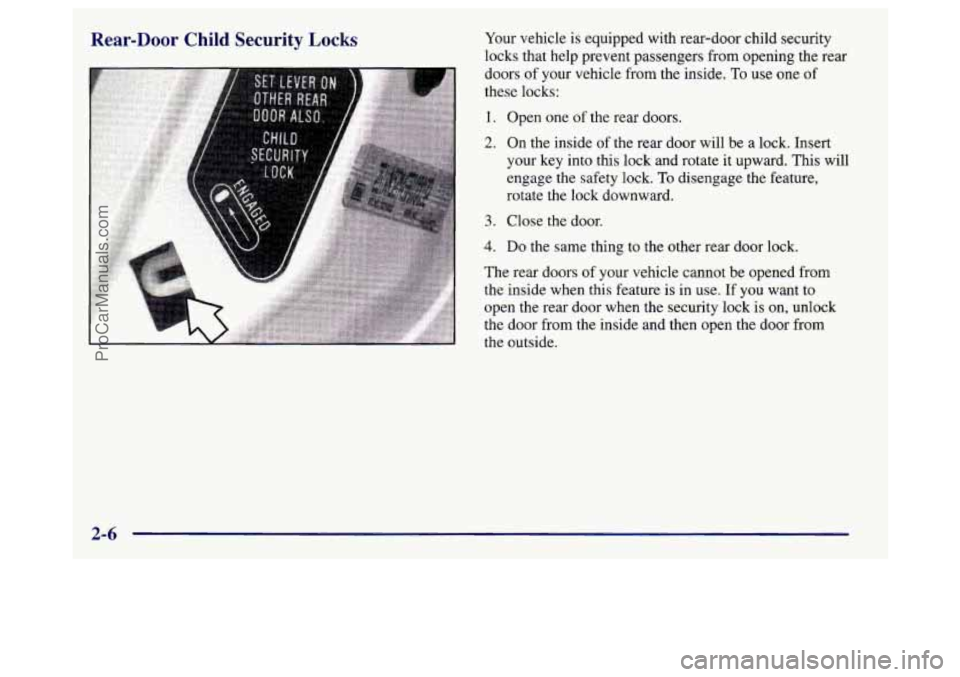
Rear-Door Child Security Locks Your vehicle is equipped with rear-door child security
locks that help prevent passengers from opening the rear
doors of your vehicle from the inside.
To use one of
these locks:
1. Open one of the rear doors.
2. On the inside of the rear door will be a lock. Insert
your key into this lock and rotate it upward. This will
engage the safety lock.
To disengage the feature,
rotate the lock downward.
3. Close the door.
4. Do the same thing to the other rear door lock.
The rear doors of your vehicle cannot be opened from
the inside when this feature is in
use. If you want to
open the rear door when the security lock is on, unlock
the door from the inside and then open the door from
the outside.
2-6
ProCarManuals.com